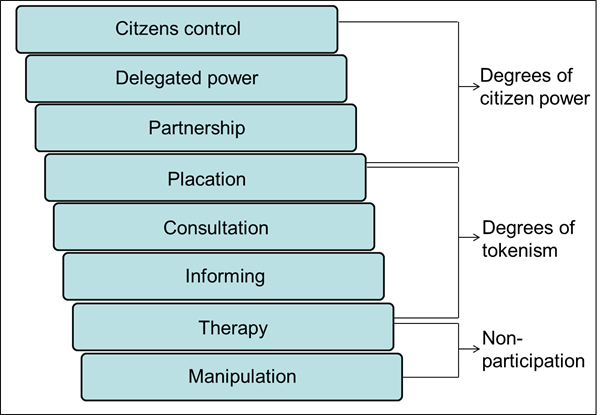Very famous is the Arnstein ladder of citizen participation (S. R. Arnstein, “A Ladder Of Citizen Participation,” (af), Journal of the American Institute of Planners, vol. 35, no. 4, pp. 216–224, 1969.). The ‘Arnstein ladder‘ describes eight different categories of citizens´ participation that are categorized in three groups. Here citizens´ participation depends on the redistribution of power, starting with non-participation of citizens that are powerless and excluded from political decision-making and ending with empowerment resp. citizens' control.

Ladder of Participation Source: Arnstein 1969, p. 217 (S. R. Arnstein, “A Ladder Of Citizen Participation,” (af), Journal of the American Institute of Planners, vol. 35, no. 4, pp. 216–224, 1969.)
Very often participation happens in the range between informing and partnership. Simplified citizens´ or public participation can be composed of:
- Information: one-way related diffusion of information produced and delivered by the government or administration. In a strict sense it´s not a form of participation because here it only covers the dissemination and passive access to information, but no real interaction. It´s a way of passive involvement of citizens.
- Consultation: a two-way related interaction in which citizens´ can provide feedback, express their opinions, needs and problems. It´s a way of active involvement of citizens.
- Active Participation: The relation between government/administration is based on dialog and partnership. Citizens adopt an active role in the decision-making process, proposing and discussing innovative alternatives and become a ‘stakeholder’. It´s a way of achieving real citizens´ participation.
Usually there are participation forms that are legally mandated. This very often applies to spatial planning, (transport) infrastructure, housing and environmental legislation (Justice and Environment. European Network of Environmental Law Organizations, Public participation in spatial planning procedures: Comparative study of six EU member states (en), and Centre for Comparative Housing Research, Review of European Planning Systems (af). Leicester. ). E.g. a local authority has to inform citizens about urban planning projects in an appropriate way.
We focus on optional and informal ways of citizens´ participation (e.g. workshops, round tables, voluntary work - see below) in railway related issues, because these can be easier implemented and are in principle feasible in different administrative system and project settings. In general optional forms of participation can countervail the decreasing opportunities of participation citizens have/feel during a project cycle. That appears because the above mentioned degrees or levels of decision making also depend at the stage of policy or project cycle from identification, design/planning, decision, implementation and maybe evaluation. As the project substantiates and comes to implementation the interest and need for communication increases, but the possibilities of engagement and influence decrease. Among other things this is due to the responsibility for a final decision which still remains at the public administration. By using a combination of different formal and in particular informal forms of participation throughout the whole project cycle you have a chance to stick to the local people.

Participation Paradox Source: Citizens’ Rail project team based on Reinert/ Sinning 1997
For the sake of completeness it has to be mentioned that there are certainly points of departure where public participation would not be serious:
- a decision has already effectively been made
- as a tick-box exercise, because it is required, but there is no will for change
- “as a delaying tactic, because it is too difficult to make a decision immediately, but the engagement is not considered an important part of the decision-making process that will eventually take place” [6, Ch. 2]
“As long as there is room for change in the policy and the results of the engagement will make a difference, it is worth considering public engagement.” [6, Ch. 2]
-----
Related reading about informal ways of citizens´ participation:
| Evaluation subject | Regional railway example |
|---|---|
| Product | Use new rolling stock, implement new rail connections or improve frequency |
| Service | Modernise ticketing system, employ more staff at stations |
| Action | Refurbish station together with citizens, develop a citizens outreach and engagement strategy |
| Project | Build or improve station, develop and implement new marketing concept |
| Participation, Governance, Organisation | Involve citizens in line or station development, implement discussion forum with rail stakeholders, establish a Community Rail Partnership |
| Programme, Strategy | Adopt a regional rail funding strategy, reform public transport strategy |
| Policy | Pass rail privatisation regulation, change rail regulation structures |
| Technology, Research | Use mobile devices for customer information and ticketing, use online participation tools |
| Formative | Summative | ||||
|---|---|---|---|---|---|
| Type of evaluation | Proactive | Clarificative | Interactive | Monitoring | Outcome evaluation |
| When? | Pre-project | Project development | Project implementation | Project implementation | Project implementation and post-project |
| Why? | To understand or clarify the need for the project | To make clear the theory of change that the project is based on | To improve the project's design (continual improvement) as it is rolled out | To ensure that the project activities are being delivered efficiently and effectively | To assess whether the project has met its goals, whether there were any unintended consequences, what were the learnings, and how to improve |
| Target? | Appropriateness | Effectiveness, efficiency |